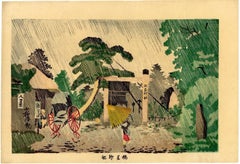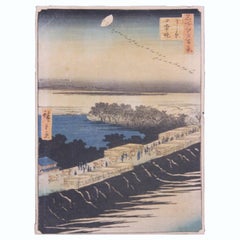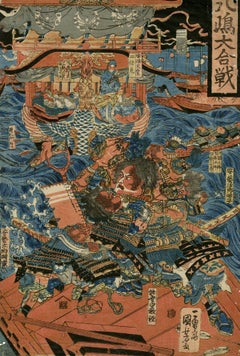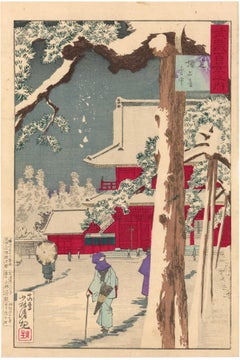Kobayashi Kiyochika Art
to
1
1
1
Overall Height
to
Overall Width
to
1
1
1
1
1
1
6,935
3,285
2,514
1,213
1
1
1
1
Artist: Kobayashi Kiyochika
Umewaka Shrine in the Rain
By Kobayashi Kiyochika
Located in Burbank, CA
Umewaka Shrine, from an untitled series of prints depicting Tokyo. A woman braces her umbrella against the rain and a man waits out the storm next to his jinriksha in this view of th...
Category
1870s Edo Kobayashi Kiyochika Art
Materials
Mulberry Paper, Handmade Paper, Woodcut
Related Items
Nihon Embankment in Yoshiwara Japanese Woodblock Print
By Utagawa Hiroshige (Ando Hiroshige)
Located in Houston, TX
Woodblock print from the Edo period. The print was apart of a series that Hiroshige did titled, "One Hundred Famous Views of Edo". The woodblock print is printed on rice paper.
The p...
Category
1850s Edo Kobayashi Kiyochika Art
Materials
Woodcut
H 13.75 in W 9.5 in D 0.004 in
The Battle of Dan-no-ura in Yashima, Nagato Province in the First Year .....
By Utagawa Yoshitora
Located in Middletown, NY
The Battle of Dan-no-ura in Yashima, Nagato Province in the First Year of the Bunji Era (1185)
Tokyo c. 1830
Woodblock print (nishiki-e) with ink and hand-coloring in watercolor on handmade mulberry paper, 14 7/16 x 9 15/16 inches (367 x 252 mm), ōban tate-e, the full sheet. In good condition with some handling creases. Colors are fresh and extremely vibrant. The right panel from the triptych by Yoshitora depicting one of Japan's most storied naval battles. An impression of this work may be found in the permanent collection of the Honolulu Museum of Art.
The great naval battle of Dan-no-ura in 1185 was the final climax in a long series of bitter wars between two powerful families in feudal Japan...
Category
Early 19th Century Edo Kobayashi Kiyochika Art
Materials
Handmade Paper, Watercolor, Woodcut
Kiyomizu Temple, Scenes of Famous Places along Tôkaidô Road - Woodblock on Paper
By Utagawa Hiroshige II
Located in Soquel, CA
Kiyomizu Temple, Scenes of Famous Places along Tôkaidô Road - Woodblock on Paper
Full Title:
Kyoto: Kiyomizu Temple (Kyô Kiyomizudera), from the series Scenes of Famous Places along...
Category
1860s Edo Kobayashi Kiyochika Art
Materials
Ink, Rice Paper, Woodcut
Edo Landscape Japanese Woodblock Print
By Utagawa Hiroshige (Ando Hiroshige)
Located in Houston, TX
Edo Meisho woodblock print of a famous Japanese coastal dock. This woodblock is most likely apart of the series "One Hundred Famous Views of Edo." The woodblock print is printed on r...
Category
1850s Edo Kobayashi Kiyochika Art
Materials
Woodcut
H 10 in W 15 in D 0.004 in
Mu-Tamagawa
Located in Middletown, NY
Woodcut in ink with embossing and hand-coloring in watercolor on laid Japon paper, 16 x 10 inches (406 x 253 mm), ōban tate-e, full margins. Scattered handling wear and toning, other...
Category
Late 19th Century Edo Kobayashi Kiyochika Art
Materials
Handmade Paper, Watercolor, Woodcut
"First Horse Day, 1896" - Chiyoda Palace - Japanese Woodblock by Chikanobu Yoshu
By Toyohara Chikanobu
Located in Soquel, CA
"First Horse Day, 1896" - Chiyoda Palace - Japanese Woodblock by Chikanobu Yoshu
Colorful and expressive court scne by Toyohara Chikanobu,"Yoshu" (Japanese, 1838-1912).
This is the r...
Category
1890s Edo Kobayashi Kiyochika Art
Materials
Rice Paper, Ink, Woodcut
H 15 in W 10.5 in D 0.5 in
Study of Utagawa Hiroshige's "View of Hara-Juku" 53 Stations of the Tokaido Road
By Utagawa Hiroshige
Located in Soquel, CA
Study of Utagawa Hiroshige's "View of Hara-Juku" 53 Stations of the Tokaido Road
Hand painted study of Utagawa Hiroshige's "View of Hara-Juku", (by unknown artist), from "53 Station...
Category
1920s Edo Kobayashi Kiyochika Art
Materials
Woodcut, Paper, Ink
H 11 in W 14 in D 0.25 in
Sumiyoshi: Dengaku dance performed during an Onda ceremony - Woodblock Print
By Utagawa Hiroshige
Located in Soquel, CA
Sumiyoshi: Dengaku dance performed during an Onda ceremony - Woodblock Print
Bright woodblock print by Utagawa Hiroshige (Japanese, 1797-1858). In this scene, two dancers with swords and fans are facing each other, in the center of a courtyard. There are spectators surrounding them, including nobles in black clothing on a balcony.
Presented in a new off-white mat with foamcore backing.
Mat size: 16"H x 20"W
Paper size: 9.63"H x 14.5W"
Utagawa Hiroshige (1797-1858, sometimes called Ando Hiroshige) was the second of the two great masters of the Japanese landscape woodblock print...
Category
1830s Edo Kobayashi Kiyochika Art
Materials
Ink, Rice Paper, Woodcut
3 Panel Hand Colored Japanese Woodcut Print Lithograph
By Keisai Eisen
Located in Soquel, CA
3 Panel Hand Colored Japanese Woodcut Print Lithograph
Three panel hand colored woodcut lithograph from Nanso Satomi hakkenden, Tale of the Eight Dogs...
Category
Early 19th Century Edo Kobayashi Kiyochika Art
Materials
Paper, Ink, Woodcut
Festival Procession Of A Daimyo - Original Woodblock Print
Located in Soquel, CA
Procession Of A Daimyo - Original Woodblock Print
Original woodblock print depicting the procession of a Daimyo. Ten Japanese soldiers are seen as they aid in transporting the Daimy...
Category
Late 18th Century Edo Kobayashi Kiyochika Art
Materials
Ink, Wood Panel, Rice Paper
"Various Himochi" Wagashi Festival Japanese Woodblock Print by Utagawa Toyokuni
Located in Soquel, CA
"Various Himochi" Wagashi Festival Japanese Woodblock Print by Utagawa Toyokuni
Rare oversized early 19th century 5-tiered woodblock by Utagawa Ichiyosai Toyokuni, (Japan, 1769-1825), a Japanese lord and wife oversee a sekku festival of food, music, and dolls or toys. '"oshi" is the first day of “Mi (Snake)” in the third month of the lunar calendar. This day, known in modern Japan as the Girls' Festival, originated in China as a form of purification ceremony in which water and drinking peach blossom wine were used to drive away evil. Many kinds of hishi-mochi appear in this picture of hina ningyo (dolls associated with Hinamatsuri, or the Girl’s Day) from Omochae.
The custom of eating special dishes at events throughout the year and at milestones in people's lives has existed since ancient times. This paragraph specifically focuses on the annual event called sekku, and life events that involve eating sweets. Joshi is the first day of “Mi (Snake)” in the third month of the lunar calendar. This day, known in modern Japan as the Girls' Festival, originated in China as a form of purification ceremony in which water and drinking peach blossom wine were used to drive away evil. According to the Keiso saijiki, in ancient China, on the third day of the third lunar month, people ate “ryuzetsuhan,” which is the juice of gogyo (Jersey cudweed) mixed with rice flour and nectar. In Japan, there is a record in the Heian period history book Nihon Montoku tenno jitsuroku [839-5] that it was an annual event to make kusamochi using gogyo on the third day of the third month of the lunar calendar, which may have been influenced by Chinese customs.
The tradition of eating kusamochi on the third day of the third month of the lunar calendar continued after that. By the Edo period, however, hishimochi had come to be used as a sweet to serve on the third day of the third month. A picture of a hishimochi is included in the Morisada manko , which we mentioned in Part 1. According to it, hishimochi in the Edo period were often three layers of green-white-green instead of the now common red-white-green. However, it is possible to see from our collection that not all hishimochi were made in this way. Omochae published in 1857, is a good example. Omochae is a type of ukiyoe print...
Category
1820s Edo Kobayashi Kiyochika Art
Materials
Ink, Rice Paper, Woodcut
H 26.75 in W 21.75 in D 0.25 in
Kintai Bridge at Iwakuni in Suo Province (Suo iwakuni kintai-bashi), 1859
By Hiroshige II
Located in Myrtle Beach, SC
Utagawa Hiroshige II (1829-1869), 'Kintai Bridge at Iwakuni in Suo Province' (Suo iwakuni kintai-bashi), from the series 'One Hundred Views of Famous Pla...
Category
1850s Edo Kobayashi Kiyochika Art
Materials
Woodcut
Previously Available Items
Chicken and Rooster
By Kobayashi Kiyochika
Located in Fairlawn, OH
Chicken and Rooster
Color woodcut with embossing, 1914-1915
Signed: Kiyochika (see photo_
Seal: Artist's red signature seal (See photo)
Publisher: Watanabe (see photo)
Format: Oban
Condition: Excellent
Image size: 11 3/8 x 15 5/8 inches
Provenance: Robert O. Muller Collection (1911-2003), famous collector and dealer
From Wikipedia, the free encyclopedia
Kobayashi Kiyochika
小林清親
Born Kobayashi Katsunosuke
10 September 1847
Edo, Japan
Died 28 November 1915 (aged 68)
Tokyo, Japan
Nationality Japanese
Movement ukiyo-e
Kobayashi Kiyochika (小林 清親, 10 September 1847 – 28 November 1915) was a Japanese ukiyo-e artist, best known for his colour woodblock prints and newspaper illustrations. His work documents the rapid modernization and Westernization Japan underwent during the Meiji period (1868–1912) and employs a sense of light and shade called kōsen-ga [ja] inspired by Western art techniques. His work first found an audience in the 1870s with prints of red-brick buildings and trains that had proliferated after the Meiji Restoration; his prints of the First Sino-Japanese War of 1894–95 were also popular. Woodblock printing fell out of favour during this period, and many collectors[who?] consider Kobayashi's work the last significant example of ukiyo-e.
Life and career
Kiyochika was born Kobayashi Katsunosuke (小林 勝之助) on 10 September 1847 (the first day of the eighth month of the ninth year of Kōka on the Japanese calendar) in Kurayashiki [ja] neighbourhood of Honjo in Edo (modern Tokyo). His father was Kobayashi Mohē (茂兵衛), who worked as a minor official in charge of unloading rice collected as taxes. His mother Chikako (知加子) was the daughter of another such official, Matsui Yasunosuke (松井安之助). The 1855 Edo earthquake destroyed the family home but left the family unharmed.
Though the youngest of his parents' nine children, Kiyochika took over as head of the household upon his father's death in 1862 and changed his name from Katsunosuke. As a subordinate to a kanjō-bugyō official Kiyochika travelled to Kyoto in 1865 with Tokugawa Iemochi's retinue, the first shogunal visit to Kyoto in over two centuries. They continued to Osaka, where Kiyochika thereafter made his home. During the Boshin War in 1868 Kiyochika participated on the side of the shōgun in the Battle of Toba–Fushimi in Kyoto and returned to Osaka after defeat of the shōgun's forces. He returned by land to Edo and re-entered the employ of the shōgun. After the fall of Edo he relocated to Shizuoka, the heartland of the Tokugawa clan, where he stayed for the next several years.
Kiyochika returned to the renamed Tokyo in May 1873 with his mother, who died there that September. He began to concentrate on art and associated with such artists as Shibata Zeshin...
Category
1910s Showa Kobayashi Kiyochika Art
Materials
Woodcut
Zojoji Temple, Shiba, in the Snow
By Kobayashi Kiyochika
Located in Burbank, CA
Zojoji Temple, Shiba, in the Snow. From the series "One Hundred Views of Musashi Province". A woman bundled up against the cold looks to her left as an overhanging pine branch lets l...
Category
1880s Edo Kobayashi Kiyochika Art
Materials
Handmade Paper, Mulberry Paper, Woodcut
Commanding Japanese Warship 5-panel Woodblock Print
By Kobayashi Kiyochika
Located in Burbank, CA
"Our Fleet Bombards Darien Bay." A commanding Japanese warship shells the fortifications at Talien (Darien) on November 6, 1894. To quote Henry Smith ...
Category
1890s Edo Kobayashi Kiyochika Art
Materials
Handmade Paper, Mulberry Paper, Woodcut
Beauty Holding a Hand Mirror
By Kobayashi Kiyochika
Located in Burbank, CA
The Tenmei Era (1781-1789). A beauty applies makeup to her face, mirror in hand marked “Best in the World”. She is beautifully attired and has translucent hair decorations with appli...
Category
Early 1900s Edo Kobayashi Kiyochika Art
Materials
Mulberry Paper, Color
Kobayashi Kiyochika art for sale on 1stDibs.
Find a wide variety of authentic Kobayashi Kiyochika art available for sale on 1stDibs. You can also browse by medium to find art by Kobayashi Kiyochika in handmade paper, mulberry paper, paper and more. Not every interior allows for large Kobayashi Kiyochika art, so small editions measuring 15 inches across are available. Customers who are interested in this artist might also find the work of Utagawa Hiroshige (Ando Hiroshige), Utagawa Yoshitora, and Toyohara Kunichika. Kobayashi Kiyochika art prices can differ depending upon medium, time period and other attributes. On 1stDibs, the price for these items starts at $2,900 and tops out at $2,900, while the average work can sell for $2,900.




